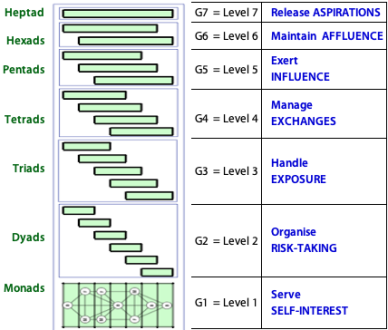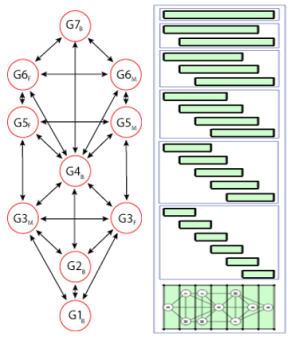The Taxonomic Investigation
Generating the Tree
The Tree to be examined in this section is the third element in a structural hierarchy triplet. The top row of Requirements creates the final Tree, which means that, diagrammatically, the structural hierarchy is turned on its side.
In this arena, the Requirements are as follows:

|

|
Because each Level contains groups and varied complicated activities, the labelling in the Centres may need to be slightly adjusted.
Determining the Internal Duality
In the triplet, the originating Tree that captured determinants of had an internal duality as follows:
Develop a Position within Society
v
Become Secure within Society .
The lower part of the internal duality of the would therefore be expected to be: Become Secure within Society—if it follows the pattern discovered for Domain Fundamentals and subsequently found to be appropriate elsewhere.
In studying the Tree from this perspective, the upper part has been provisionally labeled: .
The Tree analysis to follow will therefore be presented in two sections, Initially the lower section that is about becoming secure with your public persona, and then the upper section that is about energizing yourself to sustain that persona.
Structuring the Tree
Dynamic Duality
Trees reflect dynamic functioning in the world-as-it-is, and therefore always incorporate practical pressures and constraints. These are modeled by recognizing the influence of a dynamic duality, which states that functioning may be governed by:
- personal or individual forces, essentially self-interested, labeled P.
or
- social or communal forces, essentially impersonal, labeled S.
or
- a balance of forces, due to a synthesis or fusion of poles i.e. any activity is simultaneously responding to both personal and social forces that cannot be disentangled: labeled B.
Application of a dynamic duality to a Level converts it into one or two Tree Centres. When there are two polar opposite Centres, the more dominant one in practice is, by convention, placed on the right side of the Tree.
Psychosocial Pressure
As Levels in this Tree are derived from Groupings in the Structural Hierarchy, they will have the primary psychosocial pressures that were allocated in the previous section.
Trees are also posited to have the pressures in standard order
i.e. CL1 or KL1 = RL1, CL2 or KL2 = RL2 etc as explained here.
Channels
There is now a well-established pattern for Trees derived from a holistic hierarchy in that:
•all Centres influence Centres at the neighbouring level,
•L's 1 to 6 influence Centres that are 2 levels away;
•L7 influences the Centre that is 3 levels away.
...which makes L4 the most connected Centre—only omitting L1.
As usual, it will be necessary to consider whether this pattern of Channels does indeed apply to this Tree. We must also be confident that other possible Channels cannot or should not be activated.
The Tree pattern will be explained in terms of its internal duality as follows:
- : Centres that provide security.
then - : Centres that energize you.
Originally posted: 10-Oct-2025